| Article ID | Journal | Published Year | Pages | File Type |
|---|---|---|---|---|
| 7068878 | Bioresource Technology | 2018 | 30 Pages |
Abstract
Anaerobic digestion (AD) of lignocellulosic biomass i.e. Napier grass (Pennisetum purpureum), was investigated via a series of batch and bench-scale experiments. Two semi-continuous bench-scale horizontal bioreactors were operated in parallel for nearly 300â¯days, and the reactors were able to handle the organic loading rate (OLR) up to 6â¯kg volatile solids (VS)/m3-d, which was among the highest OLR reported in the literature for lignocellulosic biomass. Hemicellulose was the main structural carbohydrate of lignocellulosic biomass per unit respective mass (dry weight) basis contributing to methane production. The cellulose- and lignin-rich digestate was further examined for its bioenergy potential via torrefaction and hydrothermal carbonization, and was found to have higher mass and energy yield compared with those of raw Napier grass. The produced solid char has energy content similar to bituminous coal with low ash content. Thus, this study provided a successful integration of anaerobic digestion with thermochemical conversion representing a biorefinery concept for lignocellulosic feedstocks.
Related Topics
Physical Sciences and Engineering
Chemical Engineering
Process Chemistry and Technology
Authors
Chayanon Sawatdeenarunat, Hyungseok Nam, Sushil Adhikari, Shihwu Sung, Samir Kumar Khanal,
